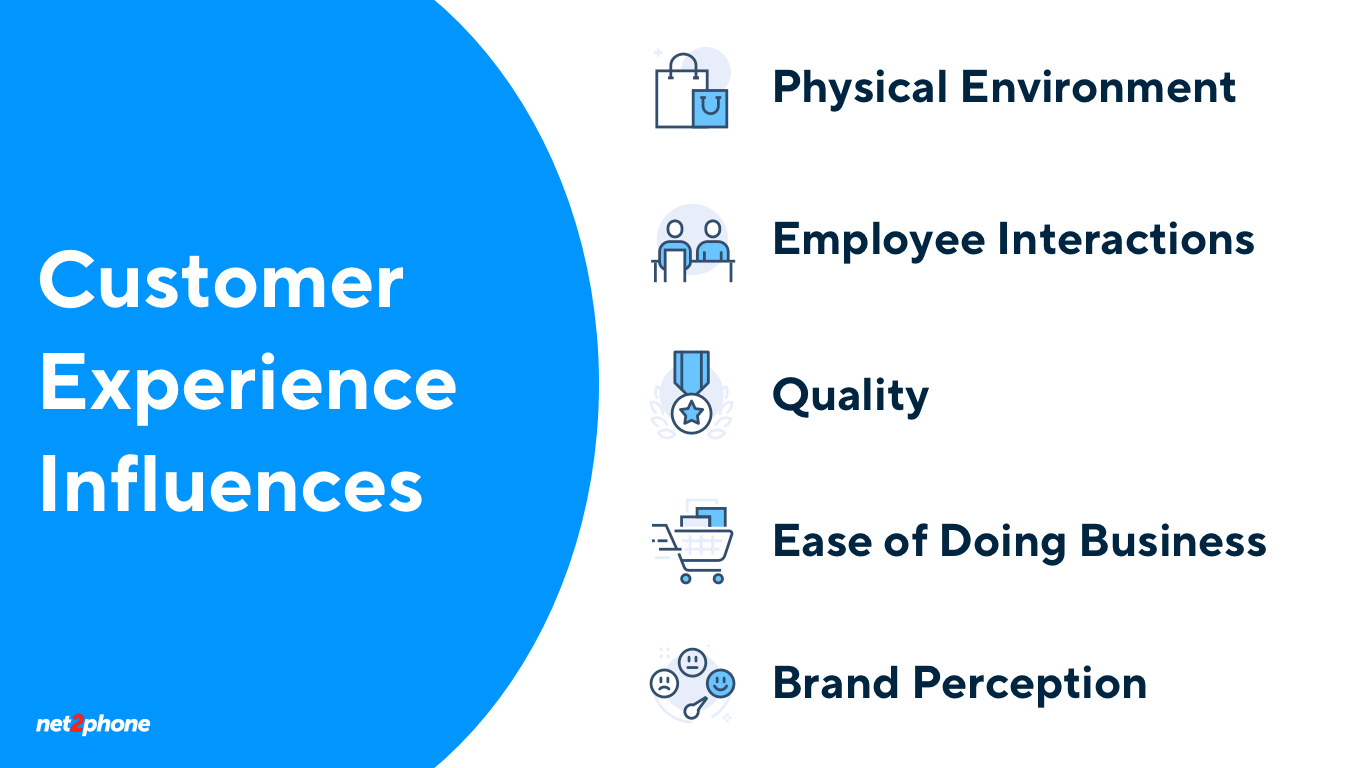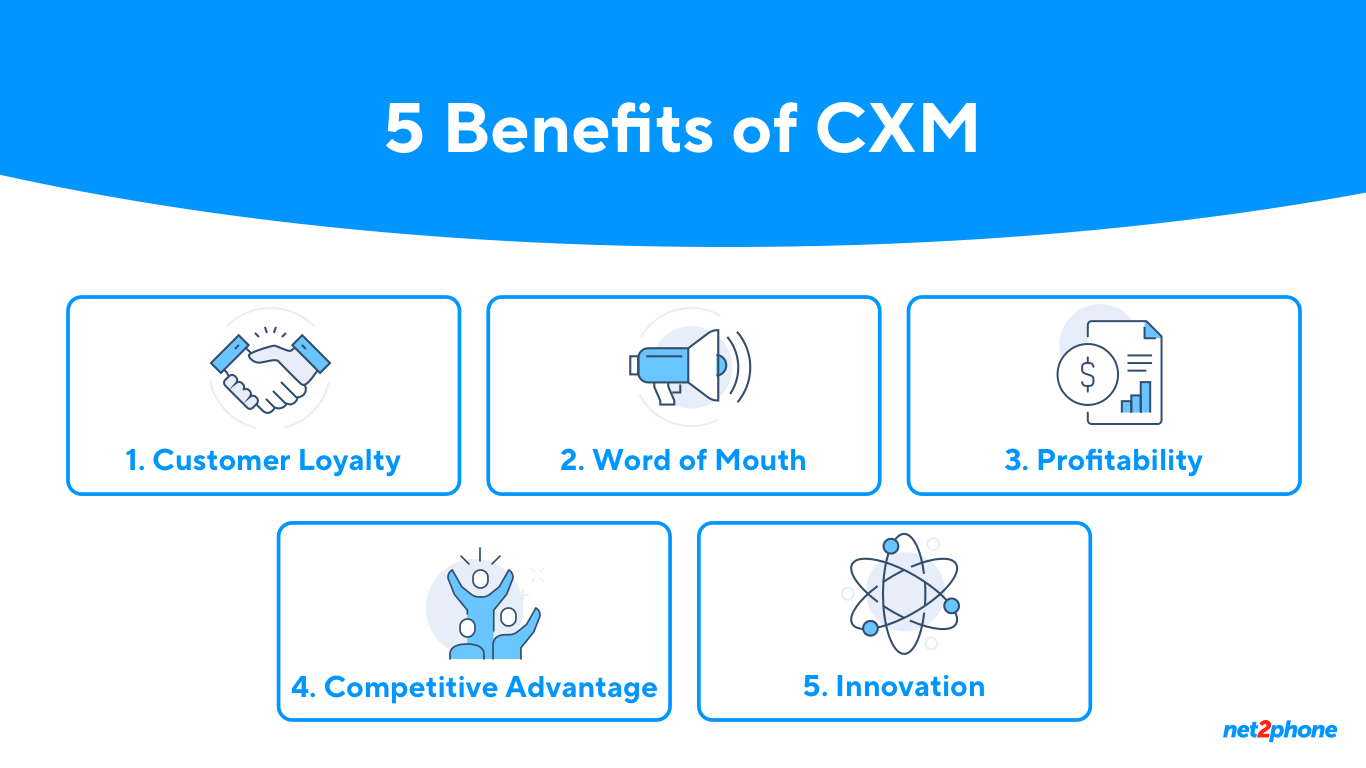Businesses of all sizes are elevating their brands from average to outstanding through customer experience management (CXM). Putting a strategic emphasis on customer experience is a powerful way to influence brand loyalty. And companies that focus on customers are 60% more profitable than those that don't.
In this guide, you will learn all about customer experience management, how it plays a role in business growth and success, explore best practices and successful customer experience management strategies that you can apply to turn customers into devoted fans!
What Is Customer Experience Management (CXM)?
Customer Experience Management, often called CXM or CEM, is a strategic approach that focuses on creating positive customer interactions at every touchpoint they have with the brand.
%3F.webp?width=1366&height=768&name=What%20is%20customer%20experience%20management%20(CXM)%3F.webp)
Imagine a future where your customers can't stop talking about how amazing your brand is, and keep coming back for more – that's the power of CXM. First, let's talk about customer experience (CX) itself.
At its core, CXM is a strategic mindset that prioritizes customers. The goal of CXM is to go above and beyond at every customer touchpoint. From the moment customers discover your brand to post-sale service, CXM aims to delight the customer at every interaction. By focusing on each touchpoint companies can foster greater customer satisfaction, loyalty and repeat business.
The customer experience begins when customers discover your brand. And it continues well after they have made a purchase. It goes beyond traditional customer service and aims to satisfy customers at every turn.
What are the Benefits of Customer Experience Management?
Deliver a great customer experience, and you can reap some serious benefits. From repeat purchases, positive word of mouth, increased revenue and profitability. Companies that focus on CXM reap great benefits, including:
- Customer loyalty, advocacy and retention
- Competitive advantage and brand differentiation
- Increased customer lifetime value
- Reduced churn
- Increased revenue and profitability
Great customer experiences are vital to achieving organizational growth and success. Prioritizing quick, friendly, consistent, and efficient service is the key. But, simply doing what the customer asks isn’t enough - you must go above and beyond. And customer experience management (CXM) is how you get there.
What Does Customer Experience Consist Of?

When it comes to winning customers over, it’s about creating experiences that delight them over at every touchpoint. A customer's experience is influenced by the following factors:
1. Physical environment and atmosphere
Whether it’s a brick-and-mortar store, a restaurant or an online platform, the environment matters. Think about IKEA, which is known for its unique retail concept. Customers can explore entire room displays in a hands-on way. The ambiance, layout, and overall aesthetics greatly affect how customers feel and perceive their experience.
2. Interactions with employees
We’ve all encountered employees who go the extra mile to ensure our satisfaction. Like a barista that remembers your order. Or a salesperson who goes above and beyond to help you find what you need.
This type of service is typical at Nordstrom. Sales associates are trained to provide tailored recommendations, listen to customer preferences and create a welcoming environment. Knowledge, friendliness and genuine engagement can transform a regular interaction into a great one.
3. Product or service quality
Think about the excitement of receiving a product or service that exceeds your expectations. Consider, for instance, the exceptional service offered by hotel brand Ritz Carlton. The hotel strives to make guests' stay memorable through proactive service and unexpected gestures.
For example, they remember guests’ room preferences and address them by name throughout their stay. When businesses consistently deliver great products or services, they build a reputation for exceptional customer experience.
4. Ease of doing business
Customers want convenience and efficiency. User-friendly interfaces, streamlined processes, and reduced friction points are important. This allows customers to engage more easily with the company.
Think Amazon, with its convenient and hassle-free online shopping. They’ve integrated features like one-click purchasing, fast shipping options, and easy returns. Purchasing from them is virtually effortless.
5. Brand perception
Crafting a strong brand that speaks to your ideal audience is essential. Consider Apple, known for sleek designs, user-friendly interfaces and innovative products. By thoughtfully curating a brand image, value and reputation, you shape how customers view your brand and the experience it offers.
Additional Elements That Make Up Successful CXM

Enhanced customer touchpoints
Each interaction a customer has with your brand is a "touchpoint." Social media, website, app, purchase process, onboarding and beyond are all examples of touchpoints. And each interaction has the power to create a positive or negative experience.
Going above and beyond
Meeting customer needs is the minimum. But brands that go above and beyond will truly stand out. CXM is about surpassing customer expectations in unexpected ways.
Think about a technical support agent that resolves a customer issue and then goes the extra mile. They take the time to offer personalized recommendations to optimize performance. And a few days later, they follow up again to ensure everything is running smoothly.
Omnichannel customer experience
Customers want to interact with brands through multiple channels like websites, social media and in person. Unified touchpoints ensure consistency. Consistency is essential for successful CXM. You want customers to receive the same level of care and attention regardless of the channel.
Consider, for example, a customer who can browse a retailer's inventory online, check store availability, pay online and pick up their purchase in-store. Despite multiple online and offline touchpoints, the shopping journey is seamlessly interconnected.
Proactive anticipation
Anticipating customer needs before they arise is a hallmark of successful CXM. Providing solutions before customers ask for them shows your commitment to their satisfaction.
For example, think of a hotel chain that remembers your room preferences based on past stays. They remember your pillow firmness or preferred room temperature and ensure those things are set up when you arrive.
Empowered employees
Engaged and empowered employees play a critical role in delivering exceptional experiences. Successful CXM involves fostering a customer-centric culture within your organization. An essential step is providing employees with the tools and autonomy they need to perform well.
For instance, you can empower sales reps with the authority to offer specific promotions or discounts. Another option is to give support reps the ability to make decisions that quickly resolve complaints.
Personalized experiences
Customers crave personalized experiences tailored to their specific preferences. Personalized recommendations and targeted promotions are examples of this. Tailored support also creates a sense of individualized care and attention.
Think about retailers that leverage customer browsing and purchase history to send relevant and personalized product recommendations and promotions.
Customer feedback and measurement
Successful CXM involves regularly gathering customer feedback. Understanding how customers perceive your brand and where you can improve is vital.
Measuring customer satisfaction, lifetime value, and other relevant metrics helps track progress and identify areas for enhancement.
Continuous improvement
Finally, CXM is an ongoing journey of improvement. Successful businesses continuously seek opportunities to enhance the customer experience. They stay informed of evolving customer demands and market dynamics.
Take, for instance, an e-commerce brand that regularly updates its website and mobile app. They make improvements based on user feedback and behaviour analytics. This approach ensures the best possible user experience.
The Importance of Customer Experience Management For Business Success

Leveraging the power of customer experience management is no longer an option - it is a strategic necessity. In a crowded marketplace it gives organizations a competitive edge and is a powerful driver for financial success.
Focusing on customer experience has several key benefits for your business success:
1. It cultivates customer loyalty and retention
Imagine a customer whose every interaction with a brand is seamless, consistent and always leaves them feeling like a VIP. Their interactions are personalized, and the company regularly goes above and beyond to please them.
Customer centricity nurtures relationships and builds trust by not only meeting customer needs, but exceeding them. This customer is likely to remain fiercely loyal and continue to choose this business over competitors.
2. It leverages the power of positive word-of-mouth
With social media, online reviews, and word of mouth, the experience customers have can shape your company's reputation.
Statistics compiled by Semrush show that 23% of people talk about their favorite products with friends and family every single day! And 90% of people are inclined to trust a brand recommended to them, even by strangers. These numbers demonstrate the power of word of mouth and it’s ability to attract new customers.
3. It drives revenue and profitability
The impact of driving better customer experiences to your business’ bottom line cannot be overstated. We’ve already shown that customers who have positive experiences are more likely to make repeat purchases, spend more, and refer others.
Did you know that customers will even pay a premium for these types of products or services?Better customer experiences can increase customer satisfaction, which can then increase revenue, and customer lifetime value for organizations.
Here are some statistics compiled by Forbes that illustrate the importance of customer experience on your financial success:
- Customer-centric companies experience 60% higher profitability than companies that don't focus on customers.
- Brands delivering superior customer experience generate 5.7 times more revenue than competitors who need a better customer experience.
- American consumers are willing to pay a premium of 17% to purchase from companies renowned for exceptional service.
- 84% of companies prioritizing customer experience see a revenue increase due to their efforts.
4. It creates a competitive advantage
Today’s marketplace is crowded, and products and services can easily be replicated. And increasingly, customers are looking for seamless, personalized experiences that cater to their needs and preferences.
Companies that deliver on these demands can gain a significant edge in the market. Statistics reveal that almost 50% of companies compete based on customer experience. This demonstrates that the focus has shifted away from price and product as key brand differentiators.
5. It reveals customer insights and fuels innovation
CXM isn't only about creating happy customers—it's also about using invaluable customer insights to innovate and grow. In developing a customer experience(CX) strategy, a company will identify customer’s needs, behaviors, preferences and pain points.
CX can be improved with this knowledge. But companies can also use this knowledge to create innovative products that are aligned with market and customer demands.
Creating A Memorable Customer Experience Strategy

Customer experience strategy involves creating an action plan for delivering exceptional customer experiences. A good CX strategy has the power to enhance customer satisfaction, build brand reputation and boost revenue. Here are some of the building blocks for creating a successful CX Strategy:
Understand your customers
It’s difficult to meet your customer’s needs if you don’t know what they are. So first, identify your target customer segments. Determine their needs, preferences, and pain points. With this understanding, you can tailor experiences that truly resonate with each target audience segment. Use surveys, interviews and data analytics to uncover actionable insights.
Map customer journeys
A customer journey map visually represents the various points where customers interact with your product and service. Consider each journey stage, from the moment they discover your brand to post-purchase support. Companies that improve customer journeys see revenue increases and cost reductions of 15-20%!
Identify touchpoints and interactions
Once you’ve mapped the customer journey, pinpoint all the touchpoints customers have with your business. Touchpoints can include your website, social media platforms, customer support channels, and physical locations. Each point of contact is an opportunity to improve and make a positive impact.
The following are examples of customer touchpoints that can occur at different stages of your customer's journey. Remember that every business will have a different journey and may employ a variety of touchpoints before and after the sale.
|
Online Customer Touchpoints
|
Offline Customer Touchpoints
|
|
Website
|
Physical Stores
|
|
Mobile App
|
In-Person Events
|
|
Social Media Platforms
|
Customer Service Centers
|
|
Email Communication
|
Print Advertisements
|
|
Live Chat
|
Direct Mail Campaigns
|
|
Online Ordering System
|
Telephone Interactions
|
|
Customer Portals
|
Product Demonstrations
|
|
Online Review and Ratings
|
In-store Interactions
|
|
Webinars and Online Training
|
Trade Shows and Exhibits
|
|
Digital Advertisements
|
Packaging
|
Set customer experience goals
You should set clear and measurable customer experience goals to drive your strategy forward. For example, you might want to increase customer satisfaction scores. Or reduce support response times and improve customer retention rates. These goals will guide your efforts and help you stay focused on your strategy.
Design processes and systems that support the strategy
Finally, design processes and implement systems that support your customer experience strategy. Ensure your employees have the tools and resources to deliver exceptional service. A streamlined workflow is also important. In this way, you will ensure a seamless customer experience across all channels.
Related: What is Customer Experience Management Strategy and How to Get Started
How To Transform Customer Experience
A CX transformation involves aligning employees, processes, and technology to create memorable customer experiences. Taking customer experience to this level demands a strategic, multi-faceted approach.
Here’s how you can begin to transform your current customer experience:
-
Set the Foundation for CX Transformation: Begin by auditing your customer’s existing experience. Identify pain points and set goals while securing leadership buy-in. This phase is about understanding where you stand and defining where you want to go.
-
Craft a Customer-Centric Strategy: The key to CX success is deeply understanding customers. Quantitative data is important, but actually speaking to customers and learning about their experience will uncover even greater insights. Find out how they interact with your business, their preferences, challenges, and needs. Meeting those needs requires a customer-centered culture where customers are prioritized across all departments.
-
Implement CX Initiatives: Equip your team with the necessary tools and knowledge to successfully implement your CX strategy and initiatives. This step involves training, empowering, and enabling employees to deliver personalized experiences and streamline customer interactions.
-
Leverage Technology and Data: To understand your customers and their evolving needs, leveraging the right technology can accelerate your efforts. For instance, data management systems allow you to analyze customer data and gain insights into prefereces. As another example, AI and machine learning have already transformed customer experience and will continue to do so. Capabilities like predictive analytics and sentiment analysis are powerful in shaping customer interactions.
-
Measure and Enhance CX: After crafting and implementing your CX initiatives, you’ll want to measure the effectiveness of your efforts. This will show you what is working and what needs to be improved or optimized. Establish and measure key performance indicators (KPIs) like net promoter score or customer satisfaction score. Another way to measure the impact of your CX efforts is to maintain continuous conversations with your customers for a regular feedback loop.
Learn more: How To Transform Customer Experience: Step By Step
Implementing Customer Experience Management
Here are some ways you can start implementing effective customer experience management strategies:
Train and empower employees
Customer-facing employees play a significant role in the customer experience.
Provide training that equips them with in-depth knowledge about products and services. In this way, you can handle customer inquiries efficiently and accurately.
Provide consistent and personalized service
Ensure that you offer the same service level across all customer touchpoints.
Along with consistency, add in personalization.
Use your customers’ names or offer tailored recommendations. The result will be greater loyalty and connection.
Leverage technology and automation
Use technology like a CRM (Customer Relationship Management) system that will help you anticipate customer needs and personalize interactions.
Implement tools like chatbots that can help streamline and automate your processes.
Measure and track customer experience metrics
Customer experience improvement requires continuous monitoring. Implement various methods to gather feedback, including surveys, feedback forms and social media monitoring.
Make continuous improvement
Customer expectations and preferences continuously evolve. Adapting and improving your customer experience strategy is crucial.
Regularly review feedback, analyze data and identify opportunities for improvement.
Best Practices For Customer Experience Management

There are a few tried and true best practices that can help companies achieve outstanding customer experiences. We explore some of these practices here:
1. Listen and respond to customer feedback
- Regularly analyze customer feedback and identify trends.
- Follow up by addressing the customer's pain points or concerns.
77% of consumers view brands more favorably when they seek and apply customer feedback.
Starbucks is a great example of a brand that does an excellent job implementing feedback. The company is well known for its commitment to customer satisfaction. They use various feedback channels to gather feedback. In-store comment cards, online surveys, and social media are some methods they use. A notable example of implementing feedback was introducing mobile ordering. It met customer desires to earn points towards free items, order drinks and pay.
2. Anticipate customer needs and preferences
- Stay updated on industry trends.
- Engage in market research.
- And use customer data to gain insight into customer behaviors and expectations.
When you can proactively identify what customers want, you can tailor your offerings and experiences to meet those needs. Netflix is known for doing this successfully. They analyze user behaviour, viewing history and ratings to understand individual preferences. Netflix uses this insight to both create and recommend content to its users.
3. Personalize the customer experience
80% of consumers say they are more likely to purchase brands that offer personalized experiences. This statistic demonstrates that people increasingly want experiences that resonate with them as individuals. Leverage your customer data and start by addressing customers by name in communications.
Recommend products and services based on previous purchases and offer tailored solutions whenever possible. Global sportswear company Nike executes this level of personalization very well. Through its loyalty program and mobile app, it gives users personalized product recommendations. It also creates customized training plans and offers users exclusive products and priority access to events.
4. Build emotional connections with customers
Make a point of providing exceptional service, making thoughtful gestures, and going above and beyond. These things will help you foster emotional connections and customer loyalty. When customers feel a genuine emotional connection with your brand, they are more likely to stay loyal to it.
Disney theme parks is well known for creating strong emotional connections with its audience through thoughtful gestures. Employees and cast members are encouraged to create random ‘magical moments’ for guests. They are allowed to do what they can to create happiness like offering free merchandise and food or skip-the-line passes.
5. Empower employees to deliver exceptional experiences
Equip employees with the tools, training, and authority to make decisions that benefit the customer. Encourage a customer-centric mindset.
Couple this with ongoing support and feedback so they can consistently provide excellent service. When employees feel empowered and valued, they become passionate brand advocates. They have the power to make a difference in the customer experience.
Southwest Airlines is a great example of a company that excels by putting their employees first. They prioritize a positive company culture and invest in employee satisfaction. he company may put its employees first, but it encourages employees to put others first and demonstrate proactive customer service. They’ve combined customer experience and employee experience. As a result, they consistently rank at the top when it comes to customer satisfaction.
How To Measure Customer Experience Metrics
If you want to know whether your CX strategies are working, you must measure your efforts.
Customer experience metrics are statistics used to measure loyalty and customer satisfaction. They provide a structured and data driven approach to understanding your customer experiences.
By regularly measuring core CX metrics, you will be able to identify what is working and where you need to drive improvements in your customer interactions. By acting on these insights, you can create better customer journeys.
Key Customer Experience Metrics
These key metrics can provide tangible insights into how customers perceive and interact with a company's products, services, or support:
- Net Promoter Score (NPS): This metric categorizes customers into ‘Promoters’, ‘Passives’, or ‘Detractors’ and helps guage customer loyalty.
- Customer Satisfaction Score (CSAT): This metric is used to determine how satisfied your customers are with your products, services, and support levels.
- Customer Effort Score (CES): This metric indicates how much effort your customers must put forth to resolve an issue or get answers they are looking for.
How to Collect, Analyze and Interpret Metrics?
Data collection, analysis, and interpretation need to be structured. Start by following these steps:
- Define Objectives: Clearly state what you want to achieve with your metrics.
- Choose Relevant Metrics: Select metrics that align with your goals, like CSAT, NPS, or revenue.
- Collect Data: Use surveys, feedback, or analytics tools to gather data.
- Analyze Data: Examine the data for trends and insights.
- Set Benchmarks: Establish performance benchmarks or targets.
- Regularly Monitor: Continuously track metrics to spot changes and trends.
- Take Action: Use insights to make informed decisions and improvements.
- Refine and Communicate: Periodically review and adjust your metrics, sharing results with your team for ongoing improvement.
Learn more: How To Measure Customer Experience & The Metrics You Should Be Tracking
Customer Feedback: How To Collect It and What To Do With It
To effectively measure and improve customer experience (CX), you must first gather customer feedback. These are the thoughts, opinions and and information that your customers have about your product, service or brand.
5 Methods for Collecting Customer Feedback
You can get feedback or source unsolicited feedback via:
- Customer Feedback Surveys and Questionnaires: Structured surveys allow you to ask specific questions and gather quantitative data to measure customer sentiment.
- Social Media and Online Reviews: Monitor social platforms and review websites to uncover unfiltered opinions and discussions about your brand.
- Customer Support Interactions, Email, and Live Chat: Conversations with your support team often yield valuable feedback and insights.
- Online Communities: Engage with customers in online forums like Slack, Reddit or Twitch to foster discussions, let your customers connect with each other, and gather feedback in a more informal setting.
- Your Own Website and Community: Leverage your website, forums or learning academies to encourage feedback and create a controlled space for discussions.
Best Practices for Effective Feedback Collection
- Use diverse sampling: Collect feedback from a wide range of customers.This way your results are not skewed towards a certain demographic or vocal minority. You will gain a more accurate picture of the broader needs of customers.
- Leverage technology: You can host virtual feedback events, conduct social media polls, or prompt users through in-app surveys. Technology makes feedback easier with widgets, AI-powered sentiment analysis, and web analytics tools.
- Analyze and extract insights: Once you’ve gathered feedback, categorizing and analyzing the data can guide your decision-making. Use feedback to extract actionable insights, identify customer pain points, customer delight factors, and identify competitive advantage.
Be aware of challenges such as feedback overload, relying on a vocal minority, and resource constraints. The key to overcoming these challenges is to prioritize feedback, seek diverse input, and implement technology and AI-driven solutions.
Learn More: How To Collect Customer Feedback And Put It To Good Use
Customer Lifetime Value: How To Measure & Why It Matters
Gaining new customers is important. Keeping them is even more critical.
This is because having a loyal customer base impacts your profitability and ability to grow over time.
Customer experience (CX) refers to all the interactions your customers have with your organization at every touchpoint along their journey. Every one of these encounters shapes their perception of your brand and their loyalty.
Customer Lifetime Value (CLV) on the other hand, represents the value that a customer brings to your company over the course of the business relationships. It includes not just their initial purchase but any repeat transactions over time.
You can calculate this metric by multiplying the customer value (the total net profit a customer generates) by the average customer lifespan.
Customer experience and CLV are closely connected.
When your customers have consistent, positive experiences with your company, they are more likely to remain loyal to you and continue to generate revenue, directly impacting CLV.
CLV can also tell you whether your CX efforts are working and if your customers are having a positive or negative experience.
Why is Customer Lifetime Value Essential?
Understanding and tracking CLV is essential for many reasons:
- Budgeting and Forecasting: CLV provides insights into the financial viability and stablity of your business model. It can help plan your budget and forecast for the future of your business.
- Customer Retention Strategies: By understanding the financial impact of customer loyalty, you can design initiatives to increase customer retention and long-term engagement.
- Business Growth: With an awareness of the potential profit generated over a customer's lifetime, you can develop retention strategies that focus on business growth.
Learn more: Customer Lifetime Value: Why It Matters & How To Measure It
Top Platforms for Successful Customer Experience Management

Knowing how to use technology to create delightful customer experiences is important.
Businesses can leverage a range of platforms and technologies. These tools allow organizations to better understand customer preferences and optimize their overall CXM strategy.
Here are some tools you should be using:
Customer Relationship Management (CRM) Software
CRM software gives a comprehensive view of your customer's interactions, preferences, and previous purchases through a centralized system.
Centralized data makes it more effective to manage customer information and analyze data. Agents can provide proactive support, anticipate needs and personalize interactions
Popular CRM tools include:
- Salesforce
- Hubspot CRM
- Zoho CRM
- Microsoft Dynamics 365
- Monday.com CRM
Contact Center Solutions
Imagine a customer reaching out with a question on their preferred channel and being quickly routed to a skilled agent.
The agent knows their name, purchase history, any existing tickets they have open, and are an expert in the solution that your customer is using.
A robust contact center solution allows you to do just this.
Further, an omnichannel contact center solution will also integrate communication channels like phone, email, SMS, social media and WhatsApp into a single platform.
With this, you can create a positive contact center customer experience.
Here are some omnichannel contact center solutions:
- net2phone uContact
- Genesys Cloud CX
- Talkdesk
- NiceCX one
- Five 9
Social Media Management Tools
Social media is influential in driving positive customer experiences.
Social media management tools let you monitor, engage and respond to customer inquiries and feedback.
If a customer DM’s you with a concern, agents can reply promptly. You can view messages and thank a customer that left a positive comment. Look for tools that let you engage in real-time conversations across various platforms.
A few popular social media management tools include:
- Hootsuite
- Sprout Social
- Zoho Social
Customer Feedback Management Tools
Customer feedback is invaluable to CMX strategy development, but how do you collect feedback, and what do you do with it?
Customer feedback management tools make it easy to gather and transform feedback into action. These tools can help automate the collection and provide analysis that can help you improve your CXM strategy.
Here are some popular customer feedback tools that businesses use today:
- SurveyMonkey
- Zendesk
- Qualtrics
Want to learn more about these, plus 6 more powerful CX tools: What Is A Customer Experience Platform? 10 Types To Use In Your Business
Challenges and Pitfalls of Customer Experience Management

Here are some common factors that often contribute to poor customer experience:
Siloed departments and lack of collaboration
Siloed departments and lack of collaboration can lead to fragmented customer experiences. Often teams work independently rather than work together in delivering customer care. Customers may experience inconsistencies and disjointed interactions, leading to poor customer experience.
Inconsistent customer experiences across channels
When customers get a different experience on your website, social media, physical location, or any other touchpoints, it creates inconsistencies. Customers may find this confusing and frustrating and can create distrust.
Failing to measure and track customer experience metrics
Businesses cannot identify areas for improvement, optimize strategies, or ensure continuous improvement of the customer experience without measuring and tracking customer experience metrics.
Neglecting employee engagement and training
Not taking the time to engage or train employees can impact the overall customer experience. Your brand will benefit greatly from engaged employees who are encouraged to provide excellent service.
Final Thoughts: What The Future Has In Store
The landscape of customer experience management is ever evolving with new technologies, new customer demands and market dynamics.
The future of CXM will require agility. Advancements in technology like AI and automation will change how businesses interact with its customers. And growing demand for personalized experiences will require organizations to invest in data-driven insights. As you move forward, here are key takeaways for implementing effective CXM:
- Place customers at the center of every decision and action.
- Leverage emerging technologies for personalized experiences, streamlined processes and data-driven insights.
- Ensure that your organization's culture is customer-centric.
- Continuously listen, adapt and respond to customer feedback. experiences will require organizations to invest in data-driven insights.
By implementing these takeaways, businesses can stay ahead of the curve, delight customers, and drive long-term success in the ever-changing world of CXM.


%3F.webp?width=1366&height=768&name=What%20is%20customer%20experience%20management%20(CXM)%3F.webp)







